-
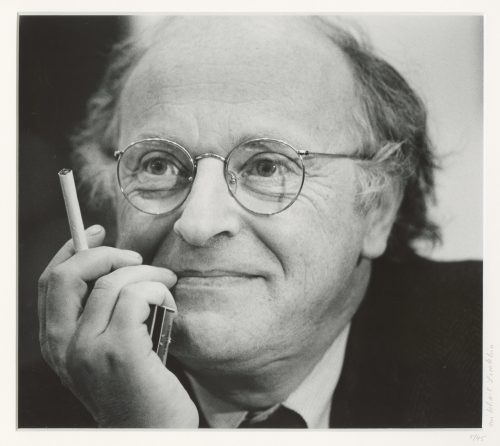 Photographic portrait of poet Joseph Brodsky, head, hand, and shoulder, three-quarters to the left, wearing glasses and with a cigarette. Pencil-signed on the mat: 5/45 • Mikhail Lemkhin; same inscription on the back of the print, and ink stamp ©Mikhail Lemkhin. Sitter: Joseph Brodsky [Иосиф Александрович Бродский ] (Russian-American-Jewish, 1940 – 1996). Size: mat: 41 x 51 cm; window: 27 x 30 cm; print: 27.7 x 35.4 cm.
Photographic portrait of poet Joseph Brodsky, head, hand, and shoulder, three-quarters to the left, wearing glasses and with a cigarette. Pencil-signed on the mat: 5/45 • Mikhail Lemkhin; same inscription on the back of the print, and ink stamp ©Mikhail Lemkhin. Sitter: Joseph Brodsky [Иосиф Александрович Бродский ] (Russian-American-Jewish, 1940 – 1996). Size: mat: 41 x 51 cm; window: 27 x 30 cm; print: 27.7 x 35.4 cm. -
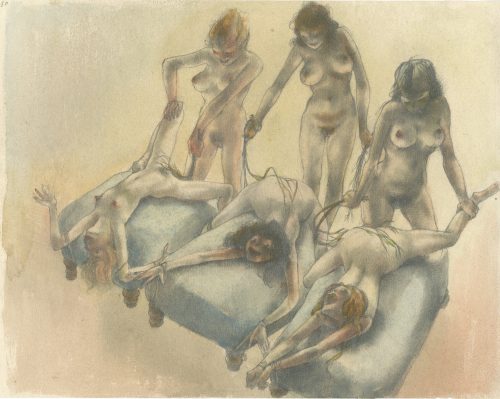 Watercolour on laid paper watermarked “HOLLAND”, 255 x 324 mm, number “10” ms pencil in the upper left corner, remnants of hinges to verso; unsigned. Attributed to Otto Rudolf Schatz (Austrian, 1900 – 1961).
Watercolour on laid paper watermarked “HOLLAND”, 255 x 324 mm, number “10” ms pencil in the upper left corner, remnants of hinges to verso; unsigned. Attributed to Otto Rudolf Schatz (Austrian, 1900 – 1961). -
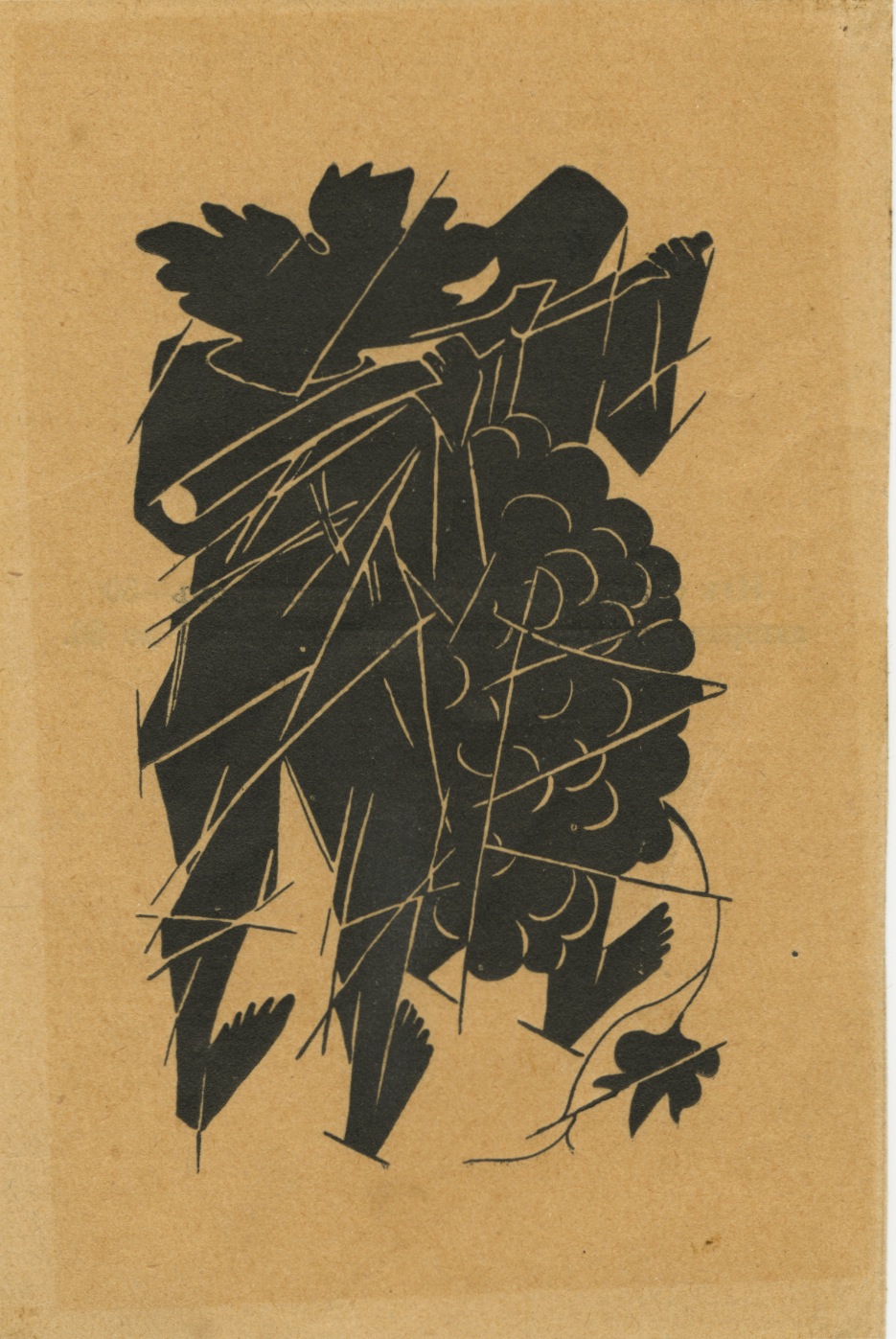 Artist: Natalia Goncharova (July 3, 1881 – October 17, 1962). Russian/French. Lithographic illustration (frontispiece) for Sergei Bobrov book of poetry "The gardeners upon the grapevines", Moscow, Lirika Publishers, 1913. Size: 18 х 11,5 cm.
Artist: Natalia Goncharova (July 3, 1881 – October 17, 1962). Russian/French. Lithographic illustration (frontispiece) for Sergei Bobrov book of poetry "The gardeners upon the grapevines", Moscow, Lirika Publishers, 1913. Size: 18 х 11,5 cm.Book was printed on May 20, 1913 for Lirika Publishers, by V. I. Voronov printshop in 500 copies, of them 50 authored and numbered. 10 lithographs by Natalia Goncharova printed at Kushneryov & Co. lithography in Moscow.
Наталия Гончарова (3 июля 1881 – 17 октября 1962). Россия/Франция. Литографическая иллюстрация (фронтиспис) к книге С. П. Боброва "Вертоградари над лозами" [Сергей Бобров. М.: /Лирика, 1913]. Формат: 18 х 11,5 см.Тираж 500 экз, из них 50 авторизованных и нумерованных. Десять цветных рисунков работы Н. Гончаровой исполнены в технике литографии на отдельных листах. Книга отпечатана 20 мая 1913 года в типографии В.И. Воронова для книгоиздательства «Лирика». В мягкой издательской обложке. На с. 162 после списка литографий: Отпечатаны литографией т-ва И.Н. Кушнерев и К° в Москве.
-
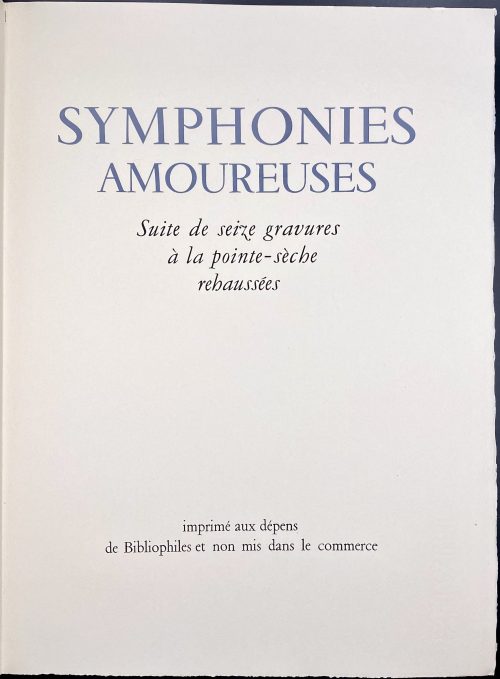 Description: Suite of 16 hand-coloured drypoints, in 39 x 29 cm, in cream French flapped wrappers with lavender lettering “SYMPHONIES AMOUREUSES” and a sanguine drypoint vignette (platemark 15 x 13 cm) to front, 17 leaves plus 2 leaves in the wrappers, 38.5 x 57 cm vertically folded once, lettering to one page, plate to another page, unbound, only the top margin trimmed, unpaginated, wove paper watermarked "BFK Rives", in a faux chagrin double slipcase 39.8 x 30 cm. Title-page (in lavender and black): SYMPHONIES AMOUREUSES | Suite de seize gravures | à la pointe sèche | rehaussées | {blank} | imprimé aux dépens | de Bibliophiles et non mis dans le commerce || Titles of the plates : 1. Ouverture. 2. Gamme. 3. Rêverie. 4. Pas redoublé. 5 Fantasia. 6. Pastorale. 7. Estudiantina. 8. Presto. 9. Arpège. 10. Menuet. 11 .Symphonie médiévale. 12. Jeux d’eau. 13. Galop. 14. Impromptu. 15. Variation. 16. Ariette. Limitation: Print run of 100 copies, 5 copies on Japon Manchou, numbered №№ 1-5, enriched; 11 copies on vélin à la forme de Rives, numbered №№ 6-16, enriched; 84 copies on vélin à la forme de Rives, numbered №№ 17-100, of which this is copy № 32. Cat. raisonné: Dutel III, № 2478. Contributors: André Collot (French, 1897 – 1976) – artist, engraver.
Description: Suite of 16 hand-coloured drypoints, in 39 x 29 cm, in cream French flapped wrappers with lavender lettering “SYMPHONIES AMOUREUSES” and a sanguine drypoint vignette (platemark 15 x 13 cm) to front, 17 leaves plus 2 leaves in the wrappers, 38.5 x 57 cm vertically folded once, lettering to one page, plate to another page, unbound, only the top margin trimmed, unpaginated, wove paper watermarked "BFK Rives", in a faux chagrin double slipcase 39.8 x 30 cm. Title-page (in lavender and black): SYMPHONIES AMOUREUSES | Suite de seize gravures | à la pointe sèche | rehaussées | {blank} | imprimé aux dépens | de Bibliophiles et non mis dans le commerce || Titles of the plates : 1. Ouverture. 2. Gamme. 3. Rêverie. 4. Pas redoublé. 5 Fantasia. 6. Pastorale. 7. Estudiantina. 8. Presto. 9. Arpège. 10. Menuet. 11 .Symphonie médiévale. 12. Jeux d’eau. 13. Galop. 14. Impromptu. 15. Variation. 16. Ariette. Limitation: Print run of 100 copies, 5 copies on Japon Manchou, numbered №№ 1-5, enriched; 11 copies on vélin à la forme de Rives, numbered №№ 6-16, enriched; 84 copies on vélin à la forme de Rives, numbered №№ 17-100, of which this is copy № 32. Cat. raisonné: Dutel III, № 2478. Contributors: André Collot (French, 1897 – 1976) – artist, engraver. -
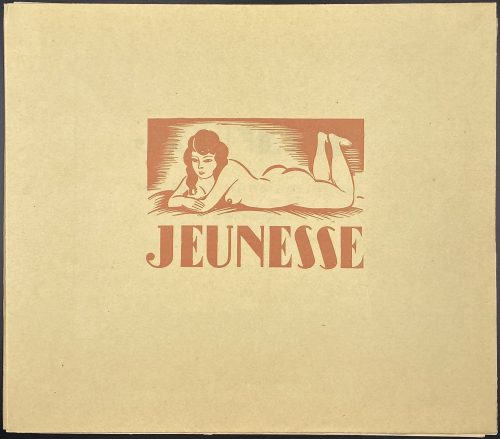 12 hand-coloured soft-ground etchings by André Collot, unbound, in a paper folder with pink lettering and vignette engraved on wood, with a title-page in black: JEUNESSE | 12 VERNIS MOUS COLORIÉS | tires à exemplaires | réservés aux Amis de l’Artiste | 1933 ||, in a frame. Edition: 1st edition, limited to 60 copies. Catalogue raisonné: Dutel 1920-70: 1786.
12 hand-coloured soft-ground etchings by André Collot, unbound, in a paper folder with pink lettering and vignette engraved on wood, with a title-page in black: JEUNESSE | 12 VERNIS MOUS COLORIÉS | tires à exemplaires | réservés aux Amis de l’Artiste | 1933 ||, in a frame. Edition: 1st edition, limited to 60 copies. Catalogue raisonné: Dutel 1920-70: 1786. -
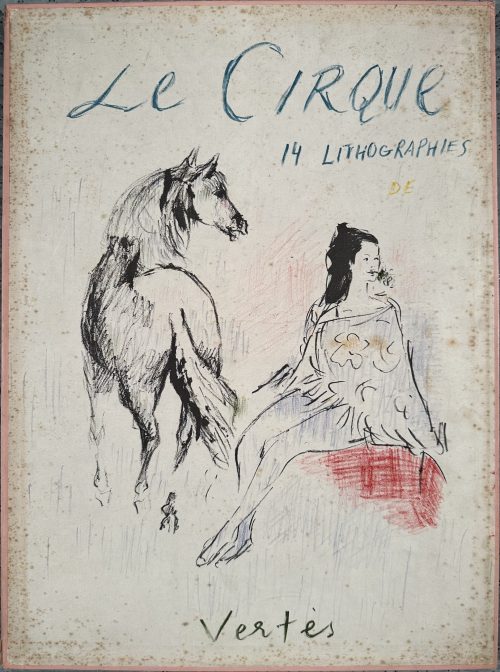 Publisher’s peach cloth box 555 x 410 mm with coloured lithograph on the lid, autographed with crayons "Le Cirque | 14 LITHOGRAPHIES | DE | {vignette} | Vertes"; in-folio unbound 4 pp. booklet on laid paper watermarked “Marais” and 14 loose leaves of plates on laid paper 520 x 395 mm without a watermark with coloured lithographs signed “Vertes” and numbered “195/250” in pencil; interleaved with tracing paper. Box and plates foxed. Title-page (red and black): LE | CIRQUE | 14 LITHOGRAPHIES DE | VERTÈS | PRÉSENTÉ | PAR | JEAN COCTEAU || Imprint: LES LIVES MERVEILLEUX | MONACO | Il a été tiré de cet album : | 150 Exemplaires, | destinés à | l'Amérique, | distribués bar les soins de | Arthur H. Harlow | de New-York, | & | 100 Exemplaires, | réservés à la France. | 15 Avril 1949 || Limitation: Edition limited to 250 copies (150 for USA, 100 for France); this is copy № 195 printed for France as the American copies marked “Published by Arthur H. Harlow & Co., New York. Seller’s Description: VERTÈS, Marcel (Hungarian-French, 1895-1961). Le Cirque 14 Lithographies de Vertès. Présénte par Jean Cocteau. [Monaco: Les Livres Merveilleux, 1949]. [vi] pp. With all 14 lithographs, each signed by the artist and numbered “195/250”. Text and lithographs 15 ¼ x 20 ½”. In original publisher’s peach cloth box with printed label on lid (box foxed, soiled, lightly worn; lithographs and text foxed). Still, a very good example of this lovely collection, with an introduction by Jean Cocteau (1889-1963). Catalogue Raisonné: Vokaer № 50. Marcel Vertès [Marcell Vértes] (Jewish-Hungarian-French, 1895 – 1961) – artist. Arthur H. Harlow (American, c. 1877 – 1958) – publisher. Jean Cocteau (French, 1889 – 1963) – author.
Publisher’s peach cloth box 555 x 410 mm with coloured lithograph on the lid, autographed with crayons "Le Cirque | 14 LITHOGRAPHIES | DE | {vignette} | Vertes"; in-folio unbound 4 pp. booklet on laid paper watermarked “Marais” and 14 loose leaves of plates on laid paper 520 x 395 mm without a watermark with coloured lithographs signed “Vertes” and numbered “195/250” in pencil; interleaved with tracing paper. Box and plates foxed. Title-page (red and black): LE | CIRQUE | 14 LITHOGRAPHIES DE | VERTÈS | PRÉSENTÉ | PAR | JEAN COCTEAU || Imprint: LES LIVES MERVEILLEUX | MONACO | Il a été tiré de cet album : | 150 Exemplaires, | destinés à | l'Amérique, | distribués bar les soins de | Arthur H. Harlow | de New-York, | & | 100 Exemplaires, | réservés à la France. | 15 Avril 1949 || Limitation: Edition limited to 250 copies (150 for USA, 100 for France); this is copy № 195 printed for France as the American copies marked “Published by Arthur H. Harlow & Co., New York. Seller’s Description: VERTÈS, Marcel (Hungarian-French, 1895-1961). Le Cirque 14 Lithographies de Vertès. Présénte par Jean Cocteau. [Monaco: Les Livres Merveilleux, 1949]. [vi] pp. With all 14 lithographs, each signed by the artist and numbered “195/250”. Text and lithographs 15 ¼ x 20 ½”. In original publisher’s peach cloth box with printed label on lid (box foxed, soiled, lightly worn; lithographs and text foxed). Still, a very good example of this lovely collection, with an introduction by Jean Cocteau (1889-1963). Catalogue Raisonné: Vokaer № 50. Marcel Vertès [Marcell Vértes] (Jewish-Hungarian-French, 1895 – 1961) – artist. Arthur H. Harlow (American, c. 1877 – 1958) – publisher. Jean Cocteau (French, 1889 – 1963) – author. -
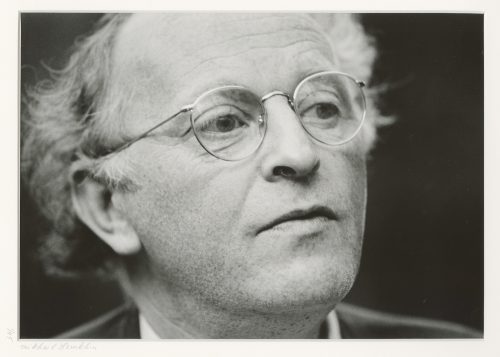 Photographic portrait of poet Joseph Brodsky, head and shoulders, three-quarters to the right, wearing glasses. Pencil-signed on the mat: 1/45 • Mikhail Lemkhin; same inscription on the back of the print, and ink stamp ©Mikhail Lemkhin. Sitter: Joseph Brodsky [Иосиф Александрович Бродский ] (Russian-American-Jewish, 1940 – 1996). Size: mat: 40.5 x 51 cm; window: 24.5 x 35 cm; print: 27.7 x 35.4 cm.
Photographic portrait of poet Joseph Brodsky, head and shoulders, three-quarters to the right, wearing glasses. Pencil-signed on the mat: 1/45 • Mikhail Lemkhin; same inscription on the back of the print, and ink stamp ©Mikhail Lemkhin. Sitter: Joseph Brodsky [Иосиф Александрович Бродский ] (Russian-American-Jewish, 1940 – 1996). Size: mat: 40.5 x 51 cm; window: 24.5 x 35 cm; print: 27.7 x 35.4 cm. -
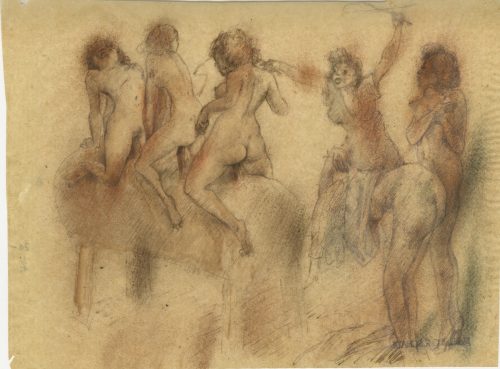 Pencil, pen and ink wash on india paper, 170 x 228 mm, black ink stamp to verso: “Nachlaß O R SCHATS”. Unsigned, attributed to Otto Rudolf Schatz (Austrian, 1900 – 1961).
Pencil, pen and ink wash on india paper, 170 x 228 mm, black ink stamp to verso: “Nachlaß O R SCHATS”. Unsigned, attributed to Otto Rudolf Schatz (Austrian, 1900 – 1961). -
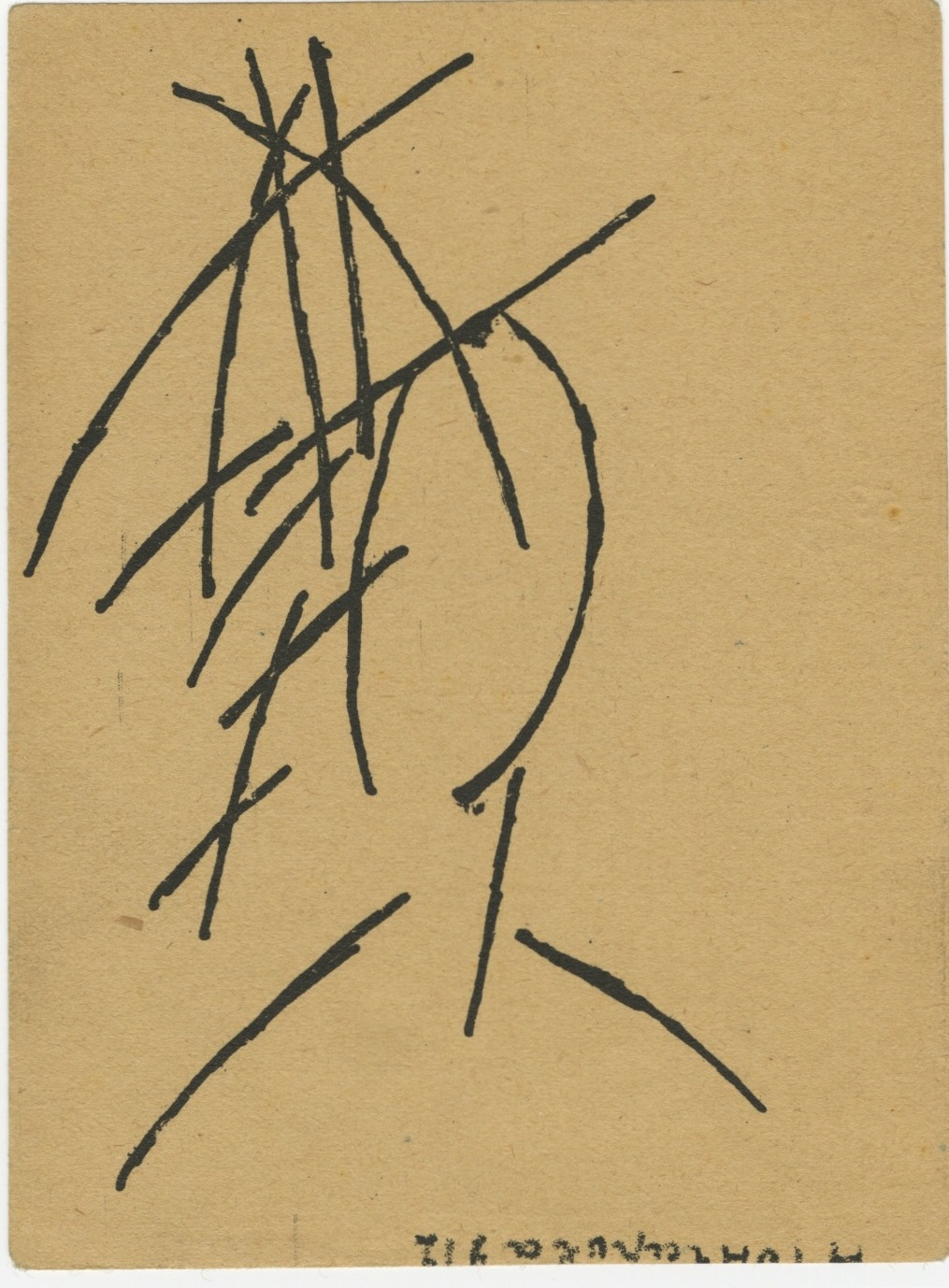 Artist: Mikhail Larionov (June 3, 1881 – May 10, 1964) ). Russian/French. Lithographic illustration "Woman in a hat" for Aleksei Kruchenykh book "Lipstick", Moscow, Kuzmin and Dolinsky Publishers, 1913, 480 copies printed. Size: 11,3 х 8,2 cm. Михаил Ларионов (3 июня 1881 – 10 мая 1964). Россия/Франция. Литографическая иллюстрация "Женщина в шляпе" к книге Алексея Крученых "Помада"; М.: Изд. Г.Л. Кузьмина и С.Д. Долинского, 1913, отпечатана в 480 экз. Формат: 11,3 х 8,2 см.
Artist: Mikhail Larionov (June 3, 1881 – May 10, 1964) ). Russian/French. Lithographic illustration "Woman in a hat" for Aleksei Kruchenykh book "Lipstick", Moscow, Kuzmin and Dolinsky Publishers, 1913, 480 copies printed. Size: 11,3 х 8,2 cm. Михаил Ларионов (3 июня 1881 – 10 мая 1964). Россия/Франция. Литографическая иллюстрация "Женщина в шляпе" к книге Алексея Крученых "Помада"; М.: Изд. Г.Л. Кузьмина и С.Д. Долинского, 1913, отпечатана в 480 экз. Формат: 11,3 х 8,2 см. -
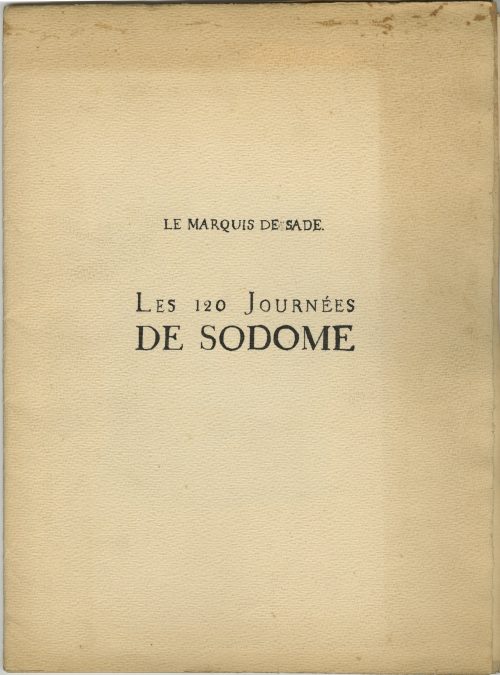 A set of sixteen pen and ink wash drawings on wove paper by an anonymous artist after lithographs by André Collot, who illustrated the 1935 edition of Les 120 journées de Sodome, ou l’école du libertinage, by the Marquis de Sade, based on the original autograph manuscript by Maurice Heine. The set is housed in a rough texture paper folder with an ink manuscript to the front: LE MARQUIS DE SADE. | Les 120 journées | DE SODOME || Size: 340 x 250 mm (folder); 335 x 252 (sheet); approx. 160 x 110 (image). Contributors: Donatien Alphonse François, Marquis de Sade (French, 1740 – 1814) – author. Maurice Heine (French, 1884 – 1940) – publisher of the original Les 120 journées. André Collot (French, 1897-1976) – artist of the original illustrations for the 1935 edition. This set was produced by an anonymous artist from the bohemian Montmartre, Montparnasse, or the School of Fine Arts, close to the booksellers', by demand of an excentric bibliophile, at about the same time. Collot's illustrations can be found at www.honesterotica.com.
A set of sixteen pen and ink wash drawings on wove paper by an anonymous artist after lithographs by André Collot, who illustrated the 1935 edition of Les 120 journées de Sodome, ou l’école du libertinage, by the Marquis de Sade, based on the original autograph manuscript by Maurice Heine. The set is housed in a rough texture paper folder with an ink manuscript to the front: LE MARQUIS DE SADE. | Les 120 journées | DE SODOME || Size: 340 x 250 mm (folder); 335 x 252 (sheet); approx. 160 x 110 (image). Contributors: Donatien Alphonse François, Marquis de Sade (French, 1740 – 1814) – author. Maurice Heine (French, 1884 – 1940) – publisher of the original Les 120 journées. André Collot (French, 1897-1976) – artist of the original illustrations for the 1935 edition. This set was produced by an anonymous artist from the bohemian Montmartre, Montparnasse, or the School of Fine Arts, close to the booksellers', by demand of an excentric bibliophile, at about the same time. Collot's illustrations can be found at www.honesterotica.com. -
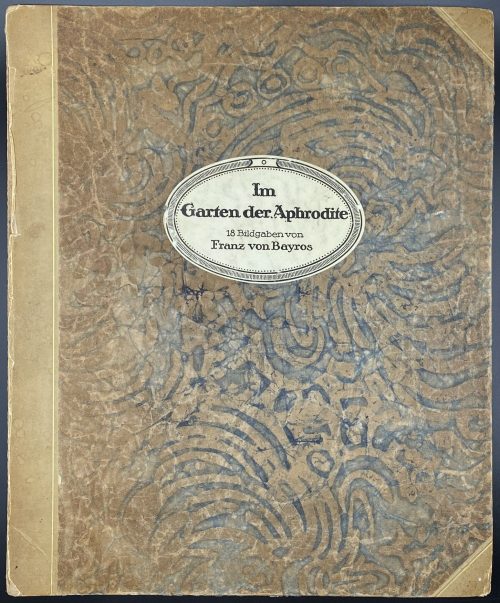 Cover with title: Im Garten der Aphrodite | 18 Bildgaben | von | Franz von Bayros | {vignette} | Privatdruck || in a frame; table of contents and limitation to verso; 18 plates with the drawings of Bayros in collotype reproduction, each mounted on cardboard and protected with the remnants of tissue guards, some lacking. Of the publisher’s folder, only the front board with an oval title label is present. Some images signed “Choisy le Conin” – von Bayros’s pseudonym. Two prints are missing: (1) Das Füßchen and (2) Die Liebesschaukel, the other 16 prints present. The vignette on the cover is a photomechanical reproduction. Edition: limited to 350 copies of which this is № 253. According to Christie’s: a collotype reprint, about twenty years after their first publication. English equivalent: The Garden of Aphrodite. Portfolio with 18 photogravures. Catalogue raisonné: The amorous drawings of the Marquis von Bayros (1968): pp. 177-1877; Bayros Zeichningen (1987): pp. 143-152.
Cover with title: Im Garten der Aphrodite | 18 Bildgaben | von | Franz von Bayros | {vignette} | Privatdruck || in a frame; table of contents and limitation to verso; 18 plates with the drawings of Bayros in collotype reproduction, each mounted on cardboard and protected with the remnants of tissue guards, some lacking. Of the publisher’s folder, only the front board with an oval title label is present. Some images signed “Choisy le Conin” – von Bayros’s pseudonym. Two prints are missing: (1) Das Füßchen and (2) Die Liebesschaukel, the other 16 prints present. The vignette on the cover is a photomechanical reproduction. Edition: limited to 350 copies of which this is № 253. According to Christie’s: a collotype reprint, about twenty years after their first publication. English equivalent: The Garden of Aphrodite. Portfolio with 18 photogravures. Catalogue raisonné: The amorous drawings of the Marquis von Bayros (1968): pp. 177-1877; Bayros Zeichningen (1987): pp. 143-152. -
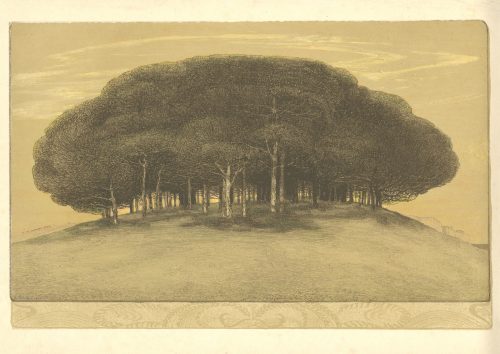 Colour (tone) lithography, image 268 x 410 mm, sheet 317 x 470 mm; signed on bottom-left of the image “Pelikan 1905”, and pencil ms inscription: E. Pelikan to the lower-right corner of the sheet. Contributor: Emilie Mediz-Pelikan (Austrian, 1861 – 1908) – artist. Seller's description: Austrian-German painter and graphic artist. Emilie Mediz-Pelikan was born in Vöcklabruck in 1861. She studied at the Vienna Academy and followed her teacher Albert Zimmermann to Salzburg and in 1885 to Munich. In 1891 she married the painter and graphic artist Karl Mediz (1868 - 1945), with whom she lived in Vienna and from 1894 in Dresden. She was in contact with the Dachau Artists' Colony and went on study trips to Paris, Belgium, Hungary and Italy. In the Dachau artists' colony she was friends with Adolf Hölzel and Fritz von Uhde. In 1889 and 1890 she spent time in Paris and in the Belgian artists' colony Knokke. In 1898 she was represented at the first art exhibition of the Vienna Secession, and in 1901 at the International Art Exhibition in Dresden. In 1903 she and her husband had a group exhibition, at the Hagenbund in Vienna. In 1904, she showed graphic works at the Dresden royal court art dealer Richter, and in 1905 and 1906 she exhibited at the Berlin Künstlerhaus. It was not until around 1900 that she achieved her artistic breakthrough with her landscape paintings. Since the estate of the artist, who died prematurely in Dresden in 1908, was lost in the former GDR until the 1980s, it was quite late that the artist was rediscovered and revalued both in Austrian art history and on the art market. In 1986, the first major exhibitions took place at the Upper Austrian State Museum and the University of Applied Arts in Vienna, followed by numerous smaller exhibitions in private galleries in Vienna, Linz and Munich. The artist received recognition during her lifetime from numerous prominent fellow painters as well as from the art critic Ludwig Hevesi. Together with Tina Blau, Herbert Boeckl, Marie Egner, Theodor von Hörmann, Franz Jaschke, Eugen Jettel, Ludwig Heinrich Jungnickel, Rudolf Junk, Gustav Klimt, Oskar Kokoschka, Johann Victor Krämer, Heinrich Kühn, Carl Moll, Rudolf Quittner, Rudolf Ribarz, Emil Jakob Schindler, Max Suppantschitsch, Max Weiler, Olga Wisinger-Florian and Alfred Zoff, she was a protagonist of the reception of Impressionism in Austria. This style went down in Austrian art history under the term "Stimmungsimpressionismus".
Colour (tone) lithography, image 268 x 410 mm, sheet 317 x 470 mm; signed on bottom-left of the image “Pelikan 1905”, and pencil ms inscription: E. Pelikan to the lower-right corner of the sheet. Contributor: Emilie Mediz-Pelikan (Austrian, 1861 – 1908) – artist. Seller's description: Austrian-German painter and graphic artist. Emilie Mediz-Pelikan was born in Vöcklabruck in 1861. She studied at the Vienna Academy and followed her teacher Albert Zimmermann to Salzburg and in 1885 to Munich. In 1891 she married the painter and graphic artist Karl Mediz (1868 - 1945), with whom she lived in Vienna and from 1894 in Dresden. She was in contact with the Dachau Artists' Colony and went on study trips to Paris, Belgium, Hungary and Italy. In the Dachau artists' colony she was friends with Adolf Hölzel and Fritz von Uhde. In 1889 and 1890 she spent time in Paris and in the Belgian artists' colony Knokke. In 1898 she was represented at the first art exhibition of the Vienna Secession, and in 1901 at the International Art Exhibition in Dresden. In 1903 she and her husband had a group exhibition, at the Hagenbund in Vienna. In 1904, she showed graphic works at the Dresden royal court art dealer Richter, and in 1905 and 1906 she exhibited at the Berlin Künstlerhaus. It was not until around 1900 that she achieved her artistic breakthrough with her landscape paintings. Since the estate of the artist, who died prematurely in Dresden in 1908, was lost in the former GDR until the 1980s, it was quite late that the artist was rediscovered and revalued both in Austrian art history and on the art market. In 1986, the first major exhibitions took place at the Upper Austrian State Museum and the University of Applied Arts in Vienna, followed by numerous smaller exhibitions in private galleries in Vienna, Linz and Munich. The artist received recognition during her lifetime from numerous prominent fellow painters as well as from the art critic Ludwig Hevesi. Together with Tina Blau, Herbert Boeckl, Marie Egner, Theodor von Hörmann, Franz Jaschke, Eugen Jettel, Ludwig Heinrich Jungnickel, Rudolf Junk, Gustav Klimt, Oskar Kokoschka, Johann Victor Krämer, Heinrich Kühn, Carl Moll, Rudolf Quittner, Rudolf Ribarz, Emil Jakob Schindler, Max Suppantschitsch, Max Weiler, Olga Wisinger-Florian and Alfred Zoff, she was a protagonist of the reception of Impressionism in Austria. This style went down in Austrian art history under the term "Stimmungsimpressionismus". -
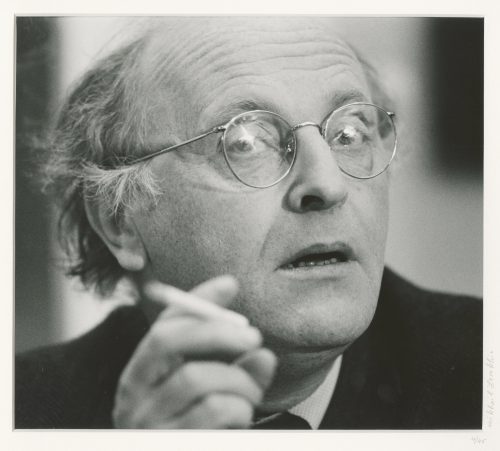 Photographic portrait of poet Joseph Brodsky, head, hand, and shoulder, three-quarters to the right, wearing glasses and with a cigarette. Pencil-signed on the mat: 4/45 • Mikhail Lemkhin; same inscription on the back of the print, and ink stamp ©Mikhail Lemkhin. Sitter: Joseph Brodsky [Иосиф Александрович Бродский ] (Russian-American-Jewish, 1940 – 1996). Size: mat: 40.5 x 51 cm; window: 26.5 x 30 cm; print: 28 x 35.4 cm.
Photographic portrait of poet Joseph Brodsky, head, hand, and shoulder, three-quarters to the right, wearing glasses and with a cigarette. Pencil-signed on the mat: 4/45 • Mikhail Lemkhin; same inscription on the back of the print, and ink stamp ©Mikhail Lemkhin. Sitter: Joseph Brodsky [Иосиф Александрович Бродский ] (Russian-American-Jewish, 1940 – 1996). Size: mat: 40.5 x 51 cm; window: 26.5 x 30 cm; print: 28 x 35.4 cm. -
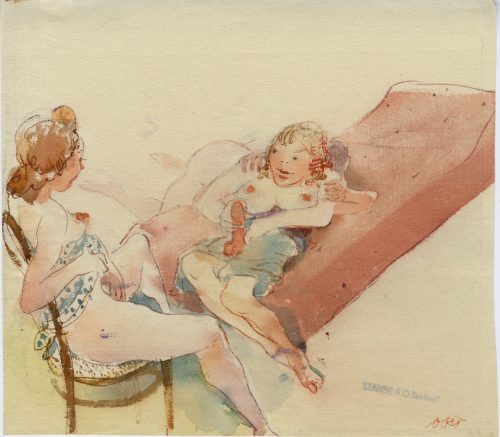 Watercolour on laid paper, 198 x 225 mm, signed or stamped in orange ink “ORS” to recto [Otto Rudolf Schatz (Austrian, 1900 – 1961)]; black ink stamp: “Nachlaß O R SCHATS”, pencil “ss” in the bottom left corner, and remnants of a hinge on the upper right to verso.
Watercolour on laid paper, 198 x 225 mm, signed or stamped in orange ink “ORS” to recto [Otto Rudolf Schatz (Austrian, 1900 – 1961)]; black ink stamp: “Nachlaß O R SCHATS”, pencil “ss” in the bottom left corner, and remnants of a hinge on the upper right to verso. -
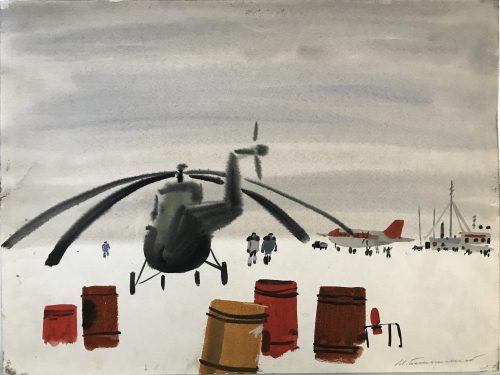 Mikhail Belomlinsky. Born 1934, Russia. Helicopter. Watercolor painting on paper from Chukotka expedition, 1975. Size: 36 x 48 cm.
Mikhail Belomlinsky. Born 1934, Russia. Helicopter. Watercolor painting on paper from Chukotka expedition, 1975. Size: 36 x 48 cm. -
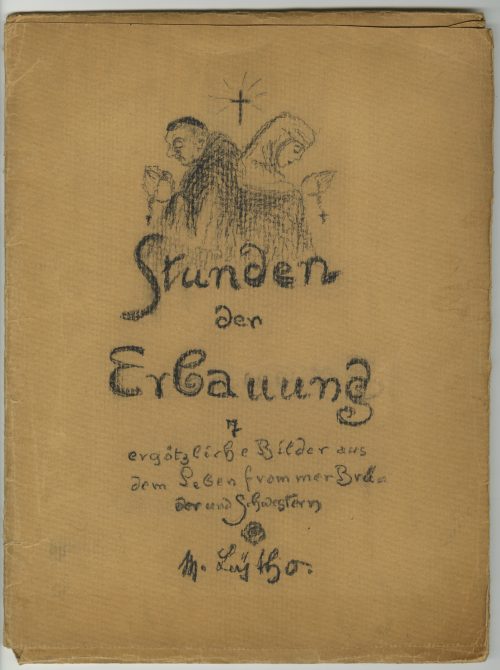 Flapped folder of thick embossed paper 353 x 263 mm, with a vignette and manuscript to front: Stunden der Erbauung | 7 | ergötz liebe Bilder aus | dem Leben frommer Brü | der und Schwestern | • | M. Leÿtho. ||, six graphite pencil drawings, each glued to a paper sheet with guard tissue; mat size 339 x 253 mm mat; drawing size 220 x 165 mm. Translation of the title: Hours of Edification / 7 delightful pictures from the lives of pious brothers and sisters. Information about the artist at www.honesterotica.com: "Mitja Leytho, almost certainly a pseudonym, is yet another mediocre yet fascinating amateur artist from the Germany of the 1920s about whom we know absolutely nothing beyond the four portfolios which bear the ‘Leytho’ signature".
Flapped folder of thick embossed paper 353 x 263 mm, with a vignette and manuscript to front: Stunden der Erbauung | 7 | ergötz liebe Bilder aus | dem Leben frommer Brü | der und Schwestern | • | M. Leÿtho. ||, six graphite pencil drawings, each glued to a paper sheet with guard tissue; mat size 339 x 253 mm mat; drawing size 220 x 165 mm. Translation of the title: Hours of Edification / 7 delightful pictures from the lives of pious brothers and sisters. Information about the artist at www.honesterotica.com: "Mitja Leytho, almost certainly a pseudonym, is yet another mediocre yet fascinating amateur artist from the Germany of the 1920s about whom we know absolutely nothing beyond the four portfolios which bear the ‘Leytho’ signature". -
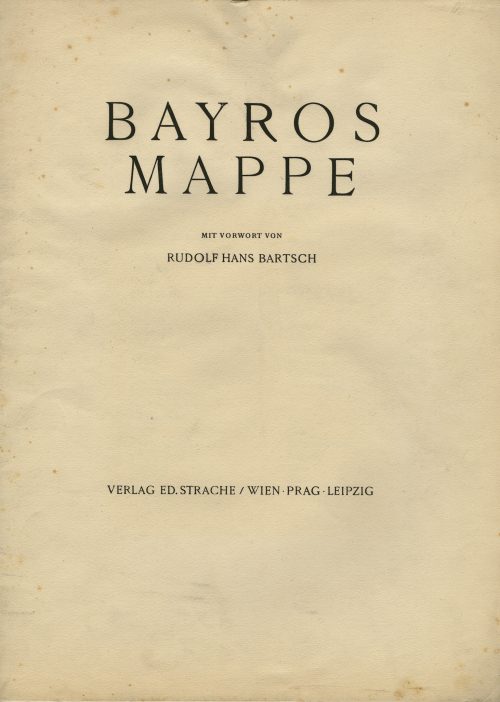 An album 45 of 50 prints, 31 photogravures and 14 in raster chromotype after drawings and paintings by Franz von Bayros; most with tissue guards, some in passepartout; colour prints mounted on the same paper that is used for photogravures. Title-page: BAYROS | MAPPE | MIT VORWORT VON | RUDOLF HANS BARTSCH | VERLAG ED. STRACHE / WIEN • PRAG • LEIPZIG || Limited edition of 500 copies. This is copy № 286. Lacking 5 prints: (1) Abschied vom Paradies, (2) Weihnacht, and (3) Harmonie from Symphonie von der Gūte, die Schönheit ist; (4) Divina commedia from Florentiner Phantasien; and (5) Mozart from Varia. Contributors: Franz von Bayros (Austrian, 1866 – 1924) Rudolf Hans Bartsch (Austrian, 1873 – 1952)
An album 45 of 50 prints, 31 photogravures and 14 in raster chromotype after drawings and paintings by Franz von Bayros; most with tissue guards, some in passepartout; colour prints mounted on the same paper that is used for photogravures. Title-page: BAYROS | MAPPE | MIT VORWORT VON | RUDOLF HANS BARTSCH | VERLAG ED. STRACHE / WIEN • PRAG • LEIPZIG || Limited edition of 500 copies. This is copy № 286. Lacking 5 prints: (1) Abschied vom Paradies, (2) Weihnacht, and (3) Harmonie from Symphonie von der Gūte, die Schönheit ist; (4) Divina commedia from Florentiner Phantasien; and (5) Mozart from Varia. Contributors: Franz von Bayros (Austrian, 1866 – 1924) Rudolf Hans Bartsch (Austrian, 1873 – 1952) -
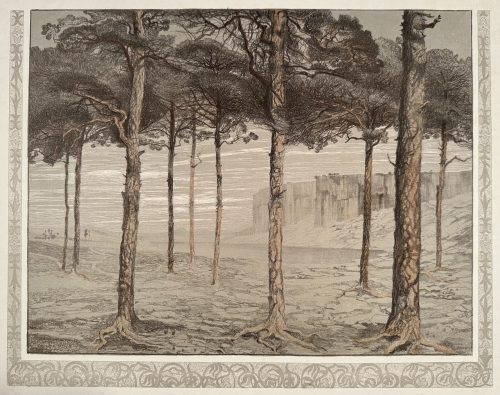 Colour (tone) lithography, image 396 x 508 mm, sheet 532 x 654 mm; before signature, undated; pencil ms inscription: Föhrenhain — E. Pelikan / 200M to the lower-right corner of the sheet. Contributor: Emilie Mediz-Pelikan (Austrian, 1861 – 1908) – artist. Seller's description: Austrian-German painter and graphic artist. Emilie Mediz-Pelikan was born in Vöcklabruck in 1861. She studied at the Vienna Academy and followed her teacher Albert Zimmermann to Salzburg and in 1885 to Munich. In 1891 she married the painter and graphic artist Karl Mediz (1868 - 1945), with whom she lived in Vienna and from 1894 in Dresden. She was in contact with the Dachau Artists' Colony and went on study trips to Paris, Belgium, Hungary and Italy. In the Dachau artists' colony she was friends with Adolf Hölzel and Fritz von Uhde. In 1889 and 1890 she spent time in Paris and in the Belgian artists' colony Knokke. In 1898 she was represented at the first art exhibition of the Vienna Secession, and in 1901 at the International Art Exhibition in Dresden. In 1903 she and her husband had a group exhibition, at the Hagenbund in Vienna. In 1904, she showed graphic works at the Dresden royal court art dealer Richter, and in 1905 and 1906 she exhibited at the Berlin Künstlerhaus. It was not until around 1900 that she achieved her artistic breakthrough with her landscape paintings. Since the estate of the artist, who died prematurely in Dresden in 1908, was lost in the former GDR until the 1980s, it was quite late that the artist was rediscovered and revalued both in Austrian art history and on the art market. In 1986, the first major exhibitions took place at the Upper Austrian State Museum and the University of Applied Arts in Vienna, followed by numerous smaller exhibitions in private galleries in Vienna, Linz and Munich. The artist received recognition during her lifetime from numerous prominent fellow painters as well as from the art critic Ludwig Hevesi. Together with Tina Blau, Herbert Boeckl, Marie Egner, Theodor von Hörmann, Franz Jaschke, Eugen Jettel, Ludwig Heinrich Jungnickel, Rudolf Junk, Gustav Klimt, Oskar Kokoschka, Johann Victor Krämer, Heinrich Kühn, Carl Moll, Rudolf Quittner, Rudolf Ribarz, Emil Jakob Schindler, Max Suppantschitsch, Max Weiler, Olga Wisinger-Florian and Alfred Zoff, she was a protagonist of the reception of Impressionism in Austria. This style went down in Austrian art history under the term "Stimmungsimpressionismus".
Colour (tone) lithography, image 396 x 508 mm, sheet 532 x 654 mm; before signature, undated; pencil ms inscription: Föhrenhain — E. Pelikan / 200M to the lower-right corner of the sheet. Contributor: Emilie Mediz-Pelikan (Austrian, 1861 – 1908) – artist. Seller's description: Austrian-German painter and graphic artist. Emilie Mediz-Pelikan was born in Vöcklabruck in 1861. She studied at the Vienna Academy and followed her teacher Albert Zimmermann to Salzburg and in 1885 to Munich. In 1891 she married the painter and graphic artist Karl Mediz (1868 - 1945), with whom she lived in Vienna and from 1894 in Dresden. She was in contact with the Dachau Artists' Colony and went on study trips to Paris, Belgium, Hungary and Italy. In the Dachau artists' colony she was friends with Adolf Hölzel and Fritz von Uhde. In 1889 and 1890 she spent time in Paris and in the Belgian artists' colony Knokke. In 1898 she was represented at the first art exhibition of the Vienna Secession, and in 1901 at the International Art Exhibition in Dresden. In 1903 she and her husband had a group exhibition, at the Hagenbund in Vienna. In 1904, she showed graphic works at the Dresden royal court art dealer Richter, and in 1905 and 1906 she exhibited at the Berlin Künstlerhaus. It was not until around 1900 that she achieved her artistic breakthrough with her landscape paintings. Since the estate of the artist, who died prematurely in Dresden in 1908, was lost in the former GDR until the 1980s, it was quite late that the artist was rediscovered and revalued both in Austrian art history and on the art market. In 1986, the first major exhibitions took place at the Upper Austrian State Museum and the University of Applied Arts in Vienna, followed by numerous smaller exhibitions in private galleries in Vienna, Linz and Munich. The artist received recognition during her lifetime from numerous prominent fellow painters as well as from the art critic Ludwig Hevesi. Together with Tina Blau, Herbert Boeckl, Marie Egner, Theodor von Hörmann, Franz Jaschke, Eugen Jettel, Ludwig Heinrich Jungnickel, Rudolf Junk, Gustav Klimt, Oskar Kokoschka, Johann Victor Krämer, Heinrich Kühn, Carl Moll, Rudolf Quittner, Rudolf Ribarz, Emil Jakob Schindler, Max Suppantschitsch, Max Weiler, Olga Wisinger-Florian and Alfred Zoff, she was a protagonist of the reception of Impressionism in Austria. This style went down in Austrian art history under the term "Stimmungsimpressionismus".


